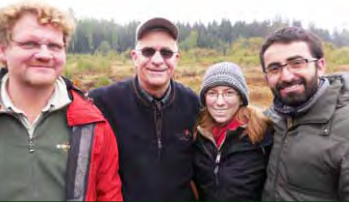
(PhD student at University of Valladolid, Spain): Standing in front of the Oak-Nelder trail, Ingolstadt.
Starting in 2002, Dr. Doug Piirto, Dr. Wally Mark, Dr. Ulric Lund, David Yun, Elicia Wise, Jason Pinkerton, Valerie Loe and other scientists researched the effects of pitch canker on the Año Nuevo native Monterey pine stands that are on the California Polytechnic State University, San Luis Obispo (Cal Poly) Swanton Pacific Ranch (SPR) in Davenport, CA. This study consisted of 27 plots of varying sizes, with 18 of these plots being planted with native Monterey pine stock. The slash of nine of these treated plots was piled and burned, while the slash on the other nine plots was lopped and scattered. Nine plots were left as control and received no treatment. The goals of this study were to better understand the effects each of these treatments had on the Monterey pine seedling survival and growth, and to investigate genetic resistance to pitch canker. This project went on for about 10 years, and Dr. Doug thought the project was largely finished.
In 2013 Dr. Hans Pretzsch, Enno Uhl and other researchers from the Wiehenstephan Forestry program at the Technical University of Munich (TUM) in Germany participated in a tour of the SPR study area and were instantly intrigued by the research opportunities the area had to offer. In January of this year, a TUM student, Max von Stern, traveled to California to work with SPR staff and students to collect data within the Monterey pine plots established by Dr. Doug and others in order to further the study.
The field data collection crew consisted of Max plus Ben Han and me (Tori Norville), graduate students from Cal Poly. We helped each other gather what was needed for our respective bachelor’s and master’s thesis studies. We worked for two and a half months, measuring the height and diameter of Monterey pine trees and observing the effects of the pitch canker disease on each of the planted trees within the 18 planted Monterey pine plots. Max’s study required core samples from trees in the surrounding stand, as well as height and diameter of those trees. By the end of the process, I had collected my master’s thesis data under the direction of Dr. Doug, Dr. Sarah Bisbing and Dr. Ulrich Lund, with an offer to travel to Germany to work on my data analysis with TUM professors, scientists and staff during the fall 2015 quarter.

In October, I traveled to Freising, Germany, along with Dr. Doug and his wife Mary. My trip was funded by the BaCaTech institute, which helps pay travel and living costs for students and faculty members traveling between Bavaria, Germany and California for research collaborations such as this.
Dr. Hans Pretzsch, Enno Uhl and others from TUM hosted us and whisked us off for forest management and sightseeing tours in the Alps. We were shown the latest scientific advances in silviculture, climate change impacts on forests, forest genetics and wood density. Dr. Doug also gave a seminar presentation about silviculture and forest management in California.
The Germany field tours enabled Dr. Doug, Mary and me to:
- Visit the town of Traunstein in the Alps. Here, TUM manages the Traunstein Municipal Forest for timber production as well as recreation, research, and wildlife using a selection forest management approach. It was learned that Germany has been trying to convert its mono-species Norway spruce (Picea abies) stands to a mixed species forest type that includes European silver fir (Abies alba), sycamore maple (Acer pseudoplatanus), birch, beech and Norway spruce. Norway spruce is the dominant species in many post-World War II planted forests, because of its value as a timber species. However, the combination of climate change, bark beetles and disease has created problems with these mature stands, necessitating a more native, mixed-species approach.
- Observe restoration of wind thrown damaged stands to a mixed forest type.
- Visit the Nationalpark Berchtesgaden in the Alps, where we took a wonderful sightseeing boat ride on the Königssee.
- Observe and discuss the Nelder experimental design trials of planted oak, funded by Audi Corporation. The circular-plot experimental design consisted of eighteen rings, each one decreasing in planted oak tree density, with the center ring the most densely planted.
- Observe TUM’s long-term Douglas-fir provenance studies.
- Observe TUM’s forest studies evaluating the effects of ozone and drought on survival and growth of spruce, beech and other native species. Measurements utilizing the latest electronic technology were occurring on the tree roots, stems, leaf litter, soil properties and much more in the treated and control plots.
- Observe the gothic architecture of Munich, Freising, Landshut and other areas.
Dr. Doug stayed in Germany during my first week, before continuing on to Finland, where he presents guest forest management and leadership lectures at Seinajoki University of Applied Sciences each year.
I have spent the fall at TUM, working with their faculty and staff to organize the field data and start statistical analysis. Dr. Doug and I also are working with the faculty at TUM and Dr. Sauli Valkonen from the Finnish Forest Research Institute on a distance-to-edge study within the Monterey pine stand at Swanton Pacific Ranch. In January, I will return to the U.S. to complete my master’s thesis at Cal Poly.

